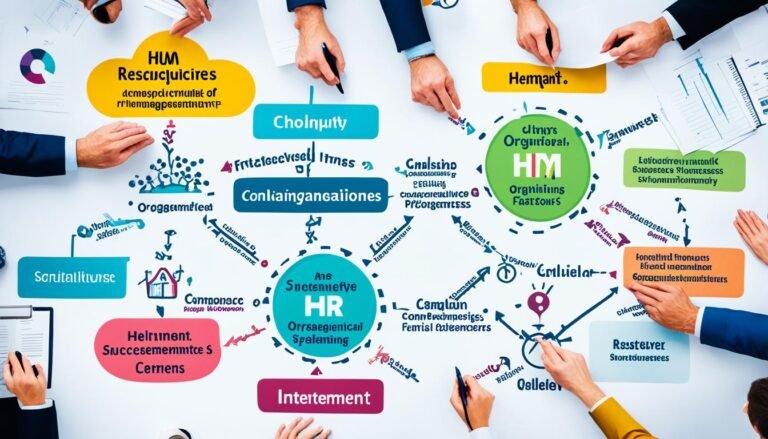What is the best approach to handle underperforming employees?
Underperforming employees might surprise you. They can even cost companies up to 30% of their annual revenue. So, it’s key for organizations to deal with this right.
Key Takeaways:
- Underperforming employees can have a significant financial impact on organizations, up to 30% of annual revenue.
- Managing underperformance requires a proactive approach.
- Strategies for dealing with underperforming employees include providing feedback, developing an action plan, and offering ongoing support and monitoring.
- Recognizing the root causes of underperformance is crucial for effective management.
- Clear communication and goal setting are essential in addressing underperformance and facilitating improvement.
What is underperformance?
Underperformance happens when an employee’s work quality is lower than needed. This can show in many ways. It makes the team and the whole organization work less well than they should. It’s key to figure out why it’s happening to deal with it right.
There are many ways underperformance can show. Some examples are not meeting set goals, acting in a way that upsets others, or not following set rules.
When these behaviors happen often, they can lower not just that person’s work quality. They can also bring down the entire team’s and the organization’s work achievements.
“Underperformance hurts how employees learn and work together. This makes reaching the company’s goals harder. Finding and fixing underperformance is critical for keeping the workplace top-notch.”
Managers and leaders must take an active role in fixing underperformance. Doing so helps in many ways. It encourages better employee growth, makes the workplace more positive, and helps meet the company’s goals.
| Effects of Underperformance | Consequences |
|---|---|
| Decreased productivity | Loss of efficiency and missed deadlines. |
| Low employee morale | Negative impact on motivation, teamwork, and organizational culture. |
| Client dissatisfaction | Poor quality work and customer complaints. |
| Workplace stress | Increased workload for other employees and reduced overall morale. |
What causes employees to underperform?
Employees might underperform due to many reasons. These can be from inside or outside the work. It’s important for companies to figure out why to help their employees do better. Some usual causes are:
- Lack of Skills: Employees might not have the right skills for their job. This could be from not enough training or the job needing more than what they can offer.
- Vague Expectations: When what’s needed from employees is unclear, they might not perform well. It’s hard for them to succeed without clear goals.
- Job Dissatisfaction: If employees are not happy, they likely won’t do their best. Feeling undervalued or lacking motivation can hurt how well they work.
- Culture Fit: If an employee doesn’t match the company’s values, they might underperform. Not feeling part of the team can impact their work.
- Stressful Work Environment: Too much work or pressure can lead to underperformance. When employees are stressed, they have a hard time focusing.
- Inadequate Training: Not getting enough training can also be a reason. Without the right skills, meeting expectations is challenging.
- Lack of Variety: Doing the same thing over and over can make employees bored. This can lead to lower performance. Giving them different tasks helps.
- Personal Issues: Personal problems like health or family can affect work. Companies should be supportive during these times.
Pinpointing why someone is underperforming is the first step. This allows companies to help in the right ways. With support and better training, employees can grow. A positive environment helps everyone perform better.
How to manage underperforming employees
Managing underperforming employees needs a hands-on strategy. Key steps like one-on-one meetings, finding the root cause, setting goals, making action plans, and supporting them ongoing helps improve performance.
One-on-One Meetings: Setting regular catch-ups can help a lot. They let you talk about what’s not working, hear the employee’s thoughts, and guide them. This approach makes it easier for everyone to share concerns and plan how to get better.
Root Cause Analysis: Figuring out why there’s a problem is crucial. Take a deep look to find what’s really causing the issues. Knowing this helps create tailored solutions and fix the main reasons for underperformance.
Goal Setting: Having clear, doable goals is key for improvement. Use SMART criteria to set goals that make sense and are achievable. Doing this helps employees know what to aim for and focus on their tasks better.
Action Plan: An action plan is essential for a full-on fix. It details what to do, what’s needed, and any help required. It’s like a step-by-step guide that aids in better performance.
Ongoing Support and Monitoring: Keeping up support is just as important as starting it. Check in regularly to see how they’re doing, offer advice, and arrange any needed help. This ongoing help shows your committed to their development and ensures they have what’s needed to do well.
Handling underperformers well is all about a solid plan. This includes talking via one-on-ones, digging deep into issues, having clear goals, making action plans, and continuously offering help and checking in. These steps help employees shine and improve overall team performance.
Identifying underperformance
Spotting when an employee is underperforming is key to good management. If you look out for certain signs, you can catch the issue early. Then, take the right steps to help the person do better. Here are signs to watch for:
- Decreased output: An employee who often doesn’t meet standards or produces low-quality work is showing a sign.
- Tardiness: Being late for work or meetings a lot can show someone is not dedicated.
- Discouraged demeanor: If an employee seems less motivated, or not excited about their work, they might be underperforming.
- Disassociation from tasks: Not caring about their duties is a clear sign. This can lead to poor performance.
- Reduced interaction with colleagues: If an employee isn’t working well with others, it can hurt teamwork and communication.
By watching for these signs, employers can act early. This early action can help the struggling employee get back on track. Employers can offer support to improve performance.

Addressing underperformance with feedback and coaching
Addressing underperformance is key to helping employees improve. A one-on-one meeting works well for this. It allows for a deep talk about what’s not going well in the person’s work.
In this meeting, the goal is to get to the bottom of the issue. You should ask questions that help you understand why the work might not be up to par. This reveals areas where support or changes are needed most.
“What obstacles do you face that hinder your performance?”
Asking about the challenges the employee is facing is crucial. It might be work-related, personal, or something else entirely. This line of questioning can unveil the real reasons for their struggles.
Additionally, using specific examples is important. It makes expectations clear and points the way to improvement. Conversations about actual cases of underperformance guide the employee on what they need to do better.
“In the recent project, you missed multiple deadlines and didn’t meet the quality standards we expect. Can you share your perspective on what led to this and how we can work together to prevent it in the future?”
Questions that dig into the root of problems and find solutions make a big difference. They encourage the individual to step up and improve their own work. A positive and supportive vibe should come from these talks, making the employee feel supported and motivated.
In summary, handling underperformance means giving feedback and coaching in a one-on-one meeting. It includes talking about the specifics of the issue, asking certain questions, and listening to the employee’s insights. This mix leads to productive conversations that help everyone involved grow and do better.
| Benefits of Addressing Underperformance | Impact on the Employee | Impact on the Organization |
|---|---|---|
| Improved individual performance | Increased job satisfaction and motivation | Enhanced productivity and efficiency |
| Retention of valuable talent | Improved morale and teamwork | Positive impact on the bottom line |
| Identifying growth opportunities | Enhanced skill development | Development of a high-performance culture |
Developing an action plan for improvement
It’s key to craft an action plan once we know what’s causing underperformance. This plan guides the employee to better their skills and performance. It involves setting clear goals, a timeframe for achieving them, and giving the right support. These steps help your team members reach their best.
Goal Setting and Performance Targets
Setting goals is essential in any improvement plan. Using the SMART method helps employees know exactly what they should do. These goals must match the company’s aims and tackle weak spots found before. They should also push employees to do their best.
Performance Improvement Timeframe
A clear deadline for improving is necessary. It has to give the person enough time to learn and grow. But it also must keep the work moving forward. Make sure this deadline is fair, taking into account the task’s complexity and how fast someone can learn. Regular check-ins help make sure things stay on track.
Support and Resources
Employees need the right tools and help to get better. This might be training classes, mentoring, or extra coaching. Or, someone more experienced can be there to support and guide them. Having the right resources and support helps team members overcome challenges and meet their targets.
| Action Plan Components | Description |
|---|---|
| Goal Setting | Define specific, measurable, achievable, relevant, and time-bound goals aligned with organizational objectives. |
| Performance Targets | Establish performance targets that challenge employees while being attainable. |
| Performance Improvement Timeframe | Assign a realistic timeframe for improvement, considering the complexity of tasks and employee learning curve. |
| Support and Resources | Provide the necessary training, mentorship, coaching, and resources to aid employees in their improvement journey. |
By creating a strong action plan, companies can beat underperformance and push their employees to do better. It’s important to keep an eye on their progress and keep supporting them. This way, they grow, and your team grows with them.
Ongoing support and monitoring
Managing underperforming employees well is key to helping them improve. It’s vital to keep checking in, making them accountable, and supporting their growth. This way, they feel encouraged to get better.
First, set up regular meetings with the underperforming team member. These meetings are for reviewing what’s working, talking about obstacles, and giving positive advice. Showing empathy and avoiding blame is crucial during these sessions.
It’s also important to keep helping them learn and develop. They might need extra learning resources, group sessions, or a mentor. By supporting their growth, companies prove that they’re committed to their team’s success.
But, it’s not just about support; it’s also about making sure they meet the set goals. By keeping goals clear and checking on progress, you ensure they keep improving. And, if something’s not working, you can adjust the plan as needed.
Bringing in relevant learning opportunities is also essential. This can be through workshops, online classes, or mentor advice. It’s important to keep an eye on how the employee is doing. This way, you’ll know if they need more help.
It’s critical to keep track of how they’re doing and give them the help they need. Creating a supportive environment helps everyone do better. It boosts individual success and the company’s overall performance.
Key Takeaways:
- Schedule regular check-ins for feedback and updates.
- Offer extra support and training for necessary skills.
- Set clear goals and make sure they meet them to see progress.
- Give employees access to relevant development resources.
Conclusion
Dealing with underperforming staff takes a hands-on strategy. It means we need to spot who’s not meeting expectations, give them feedback and guidance, set up a plan for how they can do better, and then support them as they make changes. By getting to the root cause of the issue, and ensuring they have what they need to improve, a business can make its team stronger and get better results.
Seeing the problem is the first step. Bosses might notice lower work outputs, being late, or a general lack of motivation. Once they spot these signals, they can talk to the worker in private. They aim to get employees talking and thinking about how they can do better with help.
Making a plan for improvement is key. This involves outlining what needs to get done, when it needs to happen, and how the company will help. Checking in regularly and offering more support as needed are crucial. This keeps things moving the right way and shows the employer is serious about helping.
The goal is to always be getting better. Helping low-performing workers doesn’t just help them, it makes the whole team stronger. With the right strategies and a true desire to help, workplaces can become places where everyone is growing, and that’s good for everyone.
FAQ
What is the best approach to handle underperforming employees?
The best way to deal with underperforming employees is to understand what’s going wrong. This means looking at their performance and setting clear goals. You should help them create a plan to get better and make sure you support and check on them often.
What is underperformance?
Underperformance happens when an employee doesn’t meet the job’s needed standards. This could be seen in not doing tasks like they should, causing problems, or ignoring work rules.
What causes employees to underperform?
There are many reasons why employees might not do well. This includes not being skilled or confident, not knowing what’s expected of them, hating their job, or it not fitting them well. Stress, lack of training, boring work, and personal problems can also be reasons.
How to manage underperforming employees?
To help underperforming employees, you should talk to them one-on-one. Figure out why they’re not doing well and set achievable goals. You need to make a plan with them to get better and keep checking to see how they’re doing.
How can I identify underperformance in employees?
If an employee seems uninterested in their work, is slow or poor in their output, often late or missing, looks sad, and avoids others, they might be doing poorly.
How can I address underperformance with feedback and coaching?
To address underperformance, talk to the employee alone and share what they’re not doing well. Listen to their side to know why and ask questions that make them think.
How can I develop an action plan for improvement?
Make an action plan by setting clear goals for them and deciding when they should get better. Make sure they have what they need to succeed.
How can I provide ongoing support and monitoring?
Help them by checking in on their progress regularly, giving extra training if needed, and making them responsible for their improvement.
How can effectively managing underperforming employees benefit an organization?
Managing underperforming workers can boost a company’s results, happiness, and work ethic. By finding and fixing the real issues, and giving the right help, you can make the whole team work better.








